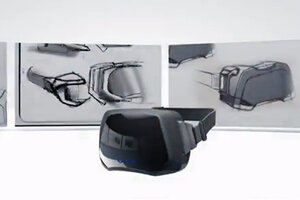The Oculus Rift aims to make virtual reality gaming viable
VR headsets have been around for decades, but they've always been bulky and expensive. The Oculus Rift, which made waves at this year's CES, could finally bring the technology into the mainstream.

The Oculus Rift, which made waves at this year's CES, could finally bring the technology into the mainstream.
Oculus VR/YouTube
Virtual reality might have been a concept ahead of its time -- VR headsets promised immersive gaming experiences in the 1990s, but bulky headsets and relatively primitive graphics kept them from being widely adopted. The technology has come a long way in 20 years, though, and now a company called Oculus is trying to put us inside games in a way that no screen can.
The Oculus Rift, one of the most talked-about products at the 2013 Consumer Electronics Show, looks like a plastic rectangle attached to a pair of ski goggles. (In fact, the original Rift prototype was literally a pair of goggles with LCD screens integrated.) But when the company approached crowd-funding site Kickstarter with a $250,000 funding request, it raised almost ten times that amount -- and attracted the attention of some big names in the gaming industry.
Now, six months later, Oculus is preparing to ship 10,000 developer headsets to its Kickstarter supporters, and we’re seeing the very first signs of Rift-compatible gaming. Team Fortress 2, the popular first-person shooter from Valve, will be getting a “VR Mode” update in a few weeks, and id Software has talked about giving Doom 4 a similar treatment. The Oculus Rift isn’t ready for consumers yet, but it’s headed in that direction. It helps that the headset will cost only a few hundred dollars -- since most of its components are the same ones found inside tablets and smart phones.
What does using the Oculus Rift feel like? Tech journalists who have been lucky enough to try a prototype headset describe a disorientingly realistic experience.
“The initial feeling of being instantly teleported is jarring,” writes Engadget’s Ben Gilbert. “You can turn your head to turn in-game, and you can freely aim all over the generous field of view without altering said field of view.” Over at The Verge, Sean Hollister writes: “With the 3D visuals, the wide field of view, and the motion tracking that shows you whatever your head points at, it feels like you’re truly in another world... only you’re looking at that world through a mesh helmet. The reality is that you’re seeing the actual rows of pixels, but your brain fills in some of the blanks.”
Compared with the complicated VR setups of yesteryear, the Oculus Rift is pretty simple: a single cable connects the goggles to a control box that accepts power and video. The headset itself can be adjusted to the shape of the user’s head, and even takes near- and far-sightedness into account.
In spite of these advances, Oculus still faces an uphill battle before VR headsets become commonplace. Convincing game companies to make compatible software is one hurdle; helping would-be users adjust to a new method of input is another (keep in mind that the Rift only responds to the user’s head movements; controlling of a video game character’s body is handled by a traditional controller). But the company hopes that its open-source ethic will enable those who are interested to help push the technology forward. And few would dispute that the headset, even in its infancy, is proof of the viability of a new approach to gaming.
Readers, what do you think about the Oculus Rift? Share your thoughts in the comments section below.
For more tech news, follow Jeff on Twitter: @jeffwardbailey.

